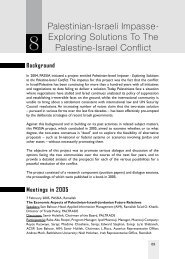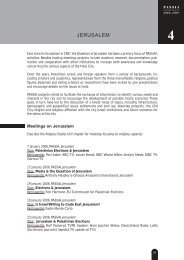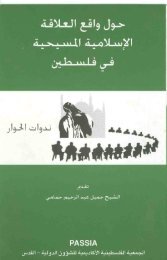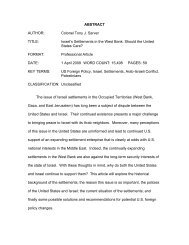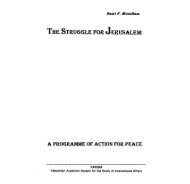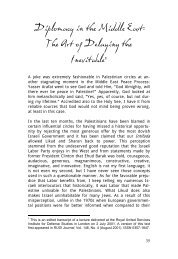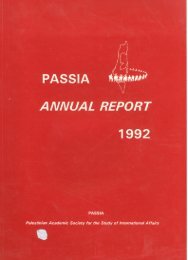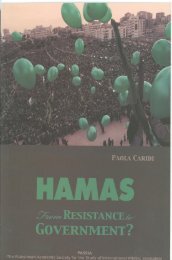The VaTican & Jerusalem - PASSIA Online Store
The VaTican & Jerusalem - PASSIA Online Store
The VaTican & Jerusalem - PASSIA Online Store
Create successful ePaper yourself
Turn your PDF publications into a flip-book with our unique Google optimized e-Paper software.
<strong>The</strong> Vatican & <strong>Jerusalem</strong>heart of his preoccupations, as for him peace was not achievable without the inclusion of the “rights andlegitimate interests of […] the [Palestinian] people who [had] been forced […] to abandon their lands.” 61Again in advance of all other Western positions, he even publicly expressed his understanding thatPalestinian acts of terrorism, on-going at the time, were essentially a result of the suffering and frustrationscaused by the Israeli occupation. 62 On the other hand however, under his pontificate the policies of theHoly See regarding the Palestine question were marked by a number of paradoxes. First of all, it is duringPaul VI’s reign at the head of the Catholic Church that Zionist influence within the Vatican started toexpand significantly. In fact, the desire of the Catholic Church following the promulgation of “NostraAetate” to improve its relations with the Jewish faith 63 and combat Judeophobia was instrumentalized bypro-Zionist groups, which used it as a means of legitimizing their political goals. <strong>The</strong>se groups, underthe contentious claim that they represented the Jewish religion as a whole, managed to become the maininterlocutors of Church bodies when dealing with theological issues such as the reinterpretation of therole of the Jews in Christian history, and they exerted considerable pressure to convince the Vatican toaccept the religious and mystical justifications of the creation of a Jewish state in Palestine. 64 <strong>The</strong>y alsomanaged to create throughout Europe and the United States numerous organizations for the so-called‘improvement of Christian-Jewish relations,’ whose real objectives were not inter-faith reconciliation butthe promotion of Zionism and Israeli interests in Catholic circles. This strategy, actively supported bythe government in Tel Aviv, 65 was to have far-reaching consequences some years later, contributing to theVatican’s acceptance, in contradiction to its traditional stance, to establish diplomatic relations with Israeldespite the absence of any progress in the peace process. 6661 Quoted in Rokach, op. cit., p. 102.62 During a general audience given after the 1972 Munich Olympic Games terrorist attacks, the Pope expressed his condemnationof the killings and rhetorically asked: “Why? What are the causes? And these too cannot but sadden us. If there is cravingto explode in such episodes, it is a sign that there is a great malaise, a great suffering of spirits, which becomes blind and indulges in theseexplosions of revenge and resentment,” Quoted in Rokach, op. cit., p. 103.63 In “Nostra Aetate,” the Catholic Church exculpated all the Jews, without distinction, of guilt for the death of Jesus.64 See for instance the details of the negotiations surrounding the writing of the “Statement on the Jews” in Rokach, op. cit. p. 57-69.65 In addition to the unofficial support for this form of lobbying, since the 1960s Israel had appointed specialized personnelwithin its embassies to follow Church affairs, a move which allowed constant informal contacts between the Holy See andIsrael despite the absence of formal relations. Nothing similar developed on the Arab side; although some Arab states hadembassies accredited to the Holy See, contacts at the time remained sporadic. Rokach, op. cit.66 Rokach, op. cit.“Nostra Aetate”and the Turning Point of 1967<strong>The</strong> Renunciation of a ‘Corpus Separatum’ for <strong>Jerusalem</strong>, in Favor of a ‘Special Statute,Internationally Guaranteed’<strong>The</strong> 1967 War turned out to be an importantmilestone in this process of progressive changein the Vatican’s relations with the state ofIsrael, as well as a turning point in its positionon <strong>Jerusalem</strong>. <strong>The</strong> Israeli occupation of theOld City, which placed all the Christian holyplaces of the area under Israel’s actual control,effectively compelled the Vatican to adopta more pragmatic stance. At first, however,the Vatican continued its support for the fullinternationalization of the city. 67 On 9 June 1967,a Vatican spokesman stated indeed that the 1947UN resolution calling for a corpus separatum wasstill “in accordance with the wishes of the HolySee.” 68 Again on 23 June, an official documentof the Vatican Observer to the United Nationsdeclared that the Holy See was “convinced thatthe only solution which offer[ed] a sufficientguarantee for the protection of <strong>Jerusalem</strong> and itsHoly Places [was] to place the city and its vicinityunder an International regime,” 69 specifying that“the term of ‘internationalization,’ in its proper Territories occupied by Israel since June 1967. © UNISPALsense should mean a separate territory, a corpusseparatum, subject to International regime.” 70 Paul VI took even further the concept of internationalizationwhen, during his allocution to the general audience of 7 June 1967, he demanded for <strong>Jerusalem</strong> not onlythe status of an ‘international regime’ but also that of an ‘Open City,’ “a shelter for the non-combatantsand the wounded” during times of war and emergency. 7167 Rudnicka-Kassem, op. cit.68 Khouri, Fred J. “<strong>The</strong> <strong>Jerusalem</strong> Question and the Vatican,” in <strong>The</strong> Vatican, Islam and the MiddleEast. Ellis, Kail C. (ed.), O.S.A., Syracuse University Press, Syracuse, New York, 1987, p. 150.69 Ferrari, op. cit., p. 323.70 Ibidem, p. 324.71 Quoted by Rokach, op. cit., p. 76.22 23



